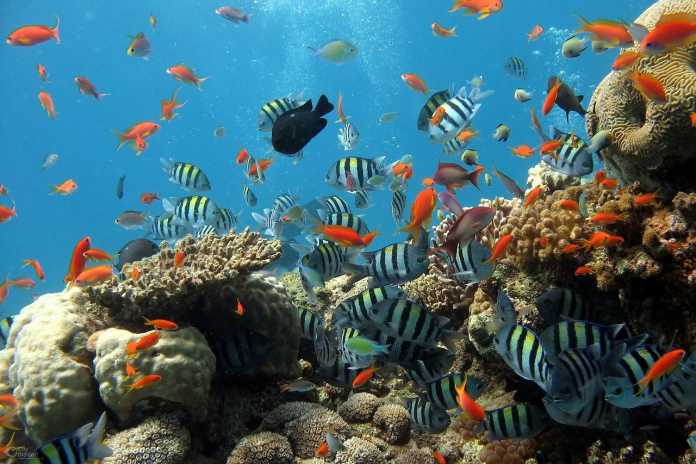A search of Google news for the term “climate change” turns up dozens of stories in the mainstream media covering a report which claims global warming has killed 14 percent of the world’s corals in the last decade. This is false. The cause of coral deaths in the past decade are multifaceted with most being the result of coastal pollution from various sources as well as a known sensitivity to sunscreen used by reef snorkelers.
Coral can only exist in warm waters and data show as the world’s equatorial oceans have warmed modestly, corals reefs expanded their range. In instances where temperature spikes have contributed to coral bleaching, most of the corals have recovered.
The New York Times, NPR, and the Washington Post were among the dozens of mainstream media outlets publishing alarming stories about a new report from the Global Coral Reef Monitoring Network (GCRMN).
“Rising ocean temperatures killed about 14 percent of the world’s coral reefs in just under a decade, according to a new analysis from the Global Coral Reef Monitoring Network,” wrote NPR.
The first corals arose during the Cambrian Period about 535 million years ago and the number and type corals increased dramatically more than 400 million years ago, coming into existence when global temperatures and carbon dioxide concentrations were much higher than at present. Coral have proved adaptable, expanding their range and evolving and thriving through periods of higher and lower temperatures than the Earth is either currently experiencing or reasonably expected to experience in the foreseeable future.
As discussed in Climate at a Glance: Coral Reefs, coral thrive in warm water, not cold water, and recent warming has allowed coral to expand their range poleward, while still thriving near the equator.
Recent peer-reviewed research described in a Phys.org article, titled “Half a trillion corals: World-first coral count prompts rethink of extinction risks,” should serve to calm any concern for the continued survival and flourishing of corals. The study cited places the number of corals in the Pacific Ocean alone at more than half a trillion. There are likely trillions more worldwide.
The scientists involved in the research say the sheer number of corals and coral species means the risk of extinction due to climate change is vastly lower than previously claimed.
“In the Pacific, we estimate there are roughly half a trillion corals,’ said the study lead author, Dr. Andy Dietzel from the ARC Centre of Excellence for Coral Reef Studies at James Cook University,” writes Phys.org. “This is about the same number of trees in the Amazon, or birds in the world.”
“Dr. Dietzel said the eight most common coral species in the region each have a population size greater than the 7.8 billion people on Earth,” says Phys.org, continuing, “The findings suggest that while a local loss of coral can be devastating to coral reefs, the global extinction risk of most coral species is lower than previously estimated.”
This research points out that 12 of the 80 coral species the International Union for the Conservation of Nature (IUCN) lists as having an elevated extinction risk, have estimated population sizes of more than one billion colonies.
NPR says the GCRMN’s “report … found that warming caused by climate change, overfishing, coastal development, and declining water quality has placed coral reefs around the world under ‘relentless stress.’”
Coral reefs do face many stressors, but the best available evidence suggests warmer waters is a factor they can adapt to.
Previous posts on Climate Realism, for example, here, here, here, and here, show local conditions, like runoff from beach front development and agriculture, and pollution tied to sun block used by swimmers, not warmer temperatures or ocean acidification, pose the biggest threat to coral reefs. But even these threats are highly localized and often temporary, with many coral reefs recovering within a few seasons after bleaching events.
Science has multiple studies showing corals can and do adapt to the gradual long-term pace of global warming.
Most portions of coral reefs around the world that have bleached and been declared dead or permanently damaged over the past two decades have, in fact, recovered. Whether the 14 percent of corals identified GCRMN as being dead will eventually recover is unknown. What is clear from history and the available evidence is there are trillions of corals in the world, many unaccounted for, and to the extent they are threatened with harm, various types of pollution are the primary cause, not warmer waters.



















So many writers in Major Magazine Publications write about Climate and Ocean level rise-
They never have a solution that makes sense and usually are speaking of north Ameica when the earth is complete system-
Been a subscriber for many Years and I would like to know if the Writers subscribe the publications to support the statements they Publish and the the Little lady in Sweden could not have obtained what she speaks of with resources to back up what She Says-
My mother was from Swedish Parents and stiff minded but Loving CCB retired PE Electrical engineer who on his Honeymoon visited a Dam and Fish Farms- We enjoyed each others Company in 1954—- Speak of Fresh water Conservation for the Growing Population-! ???
On reading these reports, I am always wondering about the basis of these estimates and measurements, i.e. changes in ocean temperature. When I do quick checks of NOAA data I don’t see any dramatic rise in temperature and at places like the Great Barrier reef more change within the reef itself than annual or periodic change. Same is true of pH. Combined with the typical inaccuracy of these measurements more than a few years ago, why are these claims ever entertained at all?